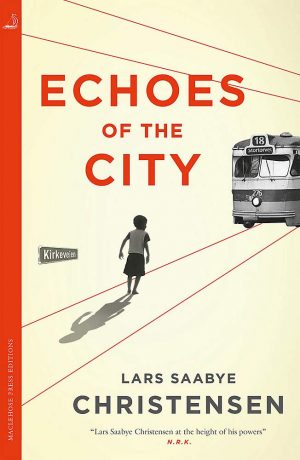Norway’s capital is perhaps not the most spectacular city in Europe, but it has seldom been more charming than in Echoes of the City by Lars Saabye Christensen, the first instalment in an ambitious trilogy tracing the lives of ordinary people in post-war Oslo. One of Norway’s most respected novelists, Saabye Christensen has managed the feat of attaining both critical acclaim and high sales.
Those born in the late 1970s found that his 1984 novel Beatles defined their generation, while The Half Brother won him the Nordic Council Literature Prize for 2001. With Echoes of the City, the last volume of which was published in Norway last year, he has once again garnered rave reviews; however, Saabye Christensen has hinted that his acclaimed trilogy might be the last thing he’ll write.
The sweeping narrative opens with a short prologue. It is 1957, and King Haakon VII, the Danish prince who became Norway’s first elected royal, is dead. Portraits of the thin, mustachioed monarch decorates every shop window in the Oslo neighbourhood of Fagerborg, where a nameless narrator, perhaps Saabye Christensen himself, shows us around. ‘A city has to be its age’, he explains, ‘Otherwise it will be like a child in a dinner jacket or an old man dressed in a sailor outfit. It will just evoke ridicule and not a longing for home.’
The story then picks up a few years after the Second World War, when Norway is slowly recovering from a time of austerity and terror. In the small, middle class area of Fagerborg, people’s lives are inextricably linked through their neighbours and acquaintances. Ewald and Maj Kristoffersen live with their ‘sensitive’ son Jesper. Above them lives Fru Vik, a middle-aged widow taken with Olaf Hall, whose stepson Bjørn saves the butcher’s son Jostein after a traffic accident. When they enter school, Jostein becomes Jesper’s closest friend. Meanwhile, the Italian pianist Enzo Zanetti struggles to keep his head above water – until he becomes Jesper’s piano tutor.
Saabye Christensen moves seamlessly between the viewpoints of his many characters, lingering first on one, then the other, as though he himself is drifting over the neighbourhoods of Fagerborg, above the longwinded Kirkeveien and the tramlines going up Majorstuen.
To contextualise the post-war era and the many lives he is handling, the author includes genuine minutes of the local Fagerborg Department of the Norwegian Red Cross. These run through the novel like a serial, anchoring the narrative in real-life acts of charity, when housewives took it upon themselves to raise modest sums and delegate them to people in need. The detailed accounts of the Red Cross’ endeavours, from handing out food parcels to knitting baby clothes, gives a fascinating glimpse of what was a decidedly female relief effort following a war fought mainly by men.
The novel’s geography and references are so utterly Norwegian, it is only due to Don Bartlett’s tremendous effort as a translator that it all becomes comprehensible to the English reader. Saabye Christensen’s smooth, winding prose is perfectly recreated, with titles and place names preserved. Bartlett trusts the English reader to stick with the characters no matter how many unfamiliar Oslo streets they decide to venture down. Echoes of the City then becomes a love letter to ordinary people, who under Saabye Christensen’s gaze become extraordinary.
Thanks to MacLehose Press for sending us a free copy of Echoes of the City in exchange for an honest review.
Echoes of the City by Lars Saabye Christensen is translated by Don Bartlett and published by MacLehose Press, 464 pages.





